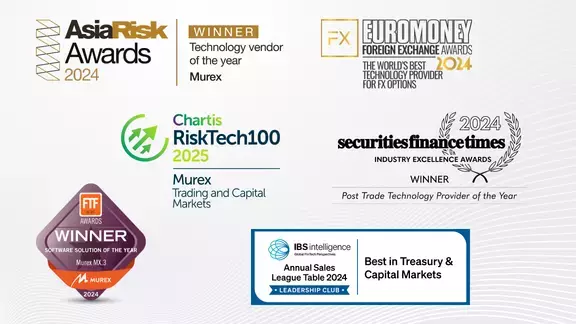-
Our solutions
- Our clients

With 300 clients and 60,000 users spread across 60 countries around the world, Murex has a truly international client base of capital markets participants.
view all case studies- Insights
- Who we are

Our awards highlight a strong level of customer satisfaction and acknowledge our market expertise.
Visit our awards webpage- Our partners
- Careers
Diversify. Scale. Accelerate: The New Approach for Resilient Financial Institutions
by Ala Haddadin, senior product marketing manager, Murex
In the first half of 2025, financial markets were shaken by geopolitical tensions, trade war fears and disruptions in energy markets. A high-pressure environment put risk management and resilience to the test.
In June, over 150 experts from more than 35 EMEA institutions joined Murex specialists and leadership in Paris for two days of knowledge-sharing, collaboration and forward-thinking perspectives at the Capital Markets Technology Forum.
Held under Chatham House rules, a group discussion on the resilience of financial institutions in volatile markets was especially engaging and timely. Firms that diversify, scale and accelerate can reinforce operational resilience, risk and business agility to respond effectively to simultaneous and rapid shifts in market conditions.
Financial institutions diversify cloud strategies to build operational resilience.
Growing concerns about European bank overreliance on a single U.S.-based cloud provider—especially amid geopolitical tensions over trade and tariffs—are driving a push for diversification across cloud strategies. This shift is reinforced by the Digital Operational Resilience Act (DORA) regulation that came into effect last January. Additionally, in July, the European Banking Authority issued guidance recommending multi-cloud adoption and geographic diversification.
Together, these factors are prompting institutions to rethink and actively redesign cloud strategies.
“Resilience always comes up,” said the treasury technology lead at a U.K.-based bank. “Three years ago, we went all-in with a single cloud vendor—it was simple. But now, we’re running systems on both AWS and Azure. We’ve scaled defensively. Technology is enabling us to do more.”
This trend is reflected in a London Stock Exchange Group survey, in which 82 percent of respondents have either a hybrid cloud environment or a strategy that leverages more than one cloud provider across their different IT systems.
Many institutions in attendance reported enhanced system availability, reduced latency and improved backup reliability after implementing multi-zone cloud hosting. The objective is clear: Preserve cloud agility without compromising resilience.
To support these emerging cloud strategies, financial institutions need flexibility from capital markets technology providers. Murex’s multi-cloud approach enables clients to run MX.3 on Azure, AWS or private cloud infrastructure, with continuous technology watch for cloud provider alternatives. Optionality allows clients to diversify and align their technology stack with resilience and regulatory requirements.
Financial institutions scale their infrastructure to support rising computational workloads.
A few years ago, market risk managers primarily relied on overnight VAR figures. Today, with increased market volatility, they require real-time risk metrics, available before trade execution and supported by comprehensive scenario impact analysis. The ability to simulate multiple extreme market scenarios intraday and assess their effects on book performance and hedging strategy allows for more timely and appropriate decision-making.
Participants agreed: Stress testing has evolved. Institutions now need to run more scenarios, faster. The challenge lies in the computational power required for full intraday computations under complex stress conditions, which can strain system performance and disrupt daily operations.
A European banking executive emphasized the stakes: “It’s critical to maintain a resilient posture. Availability is key. Being out of the market for even minutes at the wrong time can lead to significant losses.”
Scalability and elasticity are emerging as key modern risk platform attributes. “We’ve built horizontally scalable risk calculations,” a German bank executive shared. “If full capacity isn’t needed, we scale down. Our system is cloud-native and highly adaptable.”
Vendors serving this space must offer solutions that are:
Cloud-ready and elastic to handle peak volumes through auto-scaling without compromising performance
Hybrid-capable, allowing institutions to offload CPU-intensive computations to the cloud and maintaining core operations on-premises
One commodity trading firm, for example, chose Murex to support these goals: “We made a key design decision to adopt Murex to build better resilience. The markets are volatile, and our systems must handle volume peaks without breaking.”
Financial institutions accelerate workflows to respond faster to market shifts.
Whether to hedge exposures, adjust pricing models or meet client demands, institutions must respond quickly amid volatility.
“The gap between major events is shrinking, and market moves are more exaggerated,” said the head of trading at a European banking group. “It's critical to rely on the data and systems we have. Live risk monitoring is essential to quickly switch products based on market appetite.”
Real-time volatility tracking and live risk monitoring enable institutions to instantly detect and respond to emerging exposures and opportunities. This shift is transforming intraday risk management, with traders and risk managers now relying on granular, near-real-time views to monitor how risk accumulates and evolves.
“Intraday market risk reporting has become more granular and trader-driven,” a business manager at an African bank explained. “When volatility spikes, sensitivity views are needed quickly. We’ve had to optimize collateral under time constraints, sometimes running risk on subsets of data. Smaller volatility matrices and curves help. Working closely with front office and risk teams allows us to make corrections the next day.”
Volatility is rarely confined to one asset class. It ripples across equities, rates, FX and commodities. During periods of high volatility—like the one following the U.S. tariff announcement in April—an integrated, front-to-back-to-risk, cross-asset capital markets platform becomes especially valuable. The seamless data flow across functions enables institutions to respond faster and more accurately.
“During stressed liquidity, immediate funding and accurate reporting are essential,” added the head of risk at EMEA banking institution. “If market data differs across systems, it creates discrepancies. Converging our risk systems into Murex has made things easier.”
This is where tools for real-time portfolio management (RTPM) stand out. These dashboards are designed to equip traders with interactive, real-time trading and risk management data. Users monitor the impact of market data changes on portfolio pricing, credit and market risk analytics and can respond swiftly and accurately, even in periods of extreme market stress.
The participants shared how they are upgrading workflows to accelerate onboarding of new instruments and payoffs.
“Time-to-market is increasingly crucial, especially for FX and commodities. We need to scale up and buffer risk management accordingly,” said the head of trading at a European banking group. “For some underlyings, model validation takes longer than expected, and Murex plays a key role in managing that.”
Still, as several participants pointed out, building a new product in the front office is only one part of the process.
“There are 20 other touchpoints across systems that must interact with Murex [platform]. You’re only as fast as the slowest link in the chain,” one participant noted.
From pricing and booking to risk and reporting, the speed at which a product can be launched depends heavily on how well it is integrated across the organization. Institutions with a broader ready-to-use instrument catalog and standard front-to-back workflows are better positioned to move quickly. Moreover, attendees emphasized the growing importance of flexibility, particularly the ability to introduce custom products and integrate internal pricing models using low-code solutions to reduce development cycles.
This level of agility becomes possible when your technology is up to date. Institutions that treat platform upgrades as a regular, scheduled activity—not a one-off project—are better equipped to proactively accelerate product onboarding and take advantage of the latest business and performance features when market conditions demand it.
Resilience is the new black.
There’s no finish line for resilience—it’s a moving target.
As volatility becomes the norm, resilience must become a mindset. The Murex Capital Markets Technology Forum participants made it clear: Staying ready means adopting a diversified cloud strategy to preserve agility, scaling infrastructure to manage rising risk and accelerating workflows to respond swiftly to market shifts.
Achieving this level of readiness highlights the value of working with a partner that stays closely connected to clients, market dynamics, and regulatory shifts. A partner like Murex can reinforce long-term operational resilience through scalable, integrated and integrating solutions.
You might be interested in ...
- Our clients


